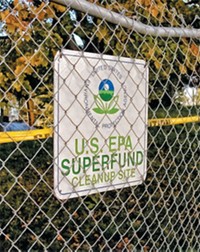Advertisement
Grab your lab coat. Let's get started
Welcome!
Welcome!
Create an account below to get 6 C&EN articles per month, receive newsletters and more - all free.
It seems this is your first time logging in online. Please enter the following information to continue.
As an ACS member you automatically get access to this site. All we need is few more details to create your reading experience.
Not you? Sign in with a different account.
Not you? Sign in with a different account.
ERROR 1
ERROR 1
ERROR 2
ERROR 2
ERROR 2
ERROR 2
ERROR 2
Password and Confirm password must match.
If you have an ACS member number, please enter it here so we can link this account to your membership. (optional)
ERROR 2
ACS values your privacy. By submitting your information, you are gaining access to C&EN and subscribing to our weekly newsletter. We use the information you provide to make your reading experience better, and we will never sell your data to third party members.
Environment
Redefining Waste
EPA proposes to allow sale, recycling of some materials regulated as hazardous waste
by Cheryl Hogue
March 19, 2007
Chemical manufacturers are cautiously praising a new EPA proposal that would allow businesses to recycle or sell some materials left over from industrial processes instead of disposing of them.
Under current rules, companies have to dispose of many coproducts, by-products, residues, and unreacted feedstocks, because these substances are regulated as hazardous wastes. EPA's proposal, announced on March 16, would exclude some of these materials from hazardous waste rules.
For example, the proposal would allow companies to sell or recycle spent metal-containing catalysts for recovery of the metals, according to EPA. Firms could also sell reprocessed liquid organic chemicals for use as solvents, the proposal says. The agency says the proposed deregulation would not apply to materials burned for energy or that fall under EPA's definition of "inherently wastelike."
Overall, the proposal would save chemical manufacturers and users $107 million per year, according to the agency. The change would involve some 4,600 facilities and 500,000 tons of material per year, EPA says.
Chemical producers and other industrial sectors, including automakers, have sought this deregulation for years. EPA took the action in response to their requests, the decisions on the issue made by federal courts, and a Bush Administration initiative, launched in 2004, to reform regulation of the U.S. manufacturing sector (C&EN, March 14, 2005, page 29).
Robert Elam, director of regulatory and technical affairs for the American Chemistry Council, says of EPA's proposal, "We're pleased with the elements that allow for legitimate recycling" of valuable materials now defined as waste. He tells C&EN that the proposal would redirect the profit reaped by the waste disposal industry "and put it in the hands of the people with the valuable materials."
Elam gives as an example the hypothetical case of a company using toluene as a solvent for manufacturing a pharmaceutical. At the end of the process, the company ends up with toluene no longer suitable for manufacturing drugs because it has trace contamination.
Current regulation requires the pharmaceutical producer to dispose of the tainted toluene as a hazardous waste product, Elam says. Under EPA's proposal, the drugmaker would be allowed to sell this leftover solvent to another company not needing pharmaceutical-grade toluene but that uses the chemical as, say, a paint thinner, he explains.
Jeffrey Gunnulfsen, senior manager of government relations for the Synthetic Organic Chemical Manufacturers Association, says the proposal includes a provision covering companies producing substances under contract for another firm. It would allow the contracting company to recycle or sell materials it reclaims, which would be an important benefit for many SOCMA member companies, Gunnulfsen tells C&EN.



Join the conversation
Contact the reporter
Submit a Letter to the Editor for publication
Engage with us on Twitter